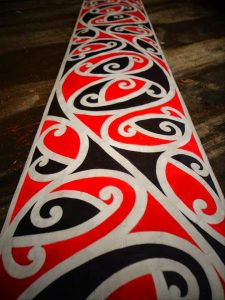Many Kiwi’s are unaware of the cultural significance of sharks, particularly the white shark to the Māori people.

Māori knew the Great White Shark by a number of names including Mangō-taniwha, ururoa and tuatini and sharks in general feature in many ancient Māori stories. This is hardly surprising considering the Māori settlers arrived by boat and the sea formed an integral part of their existence in Aotearoa. The shark has played a number of rolls in ancient Māori culture. The Te Arawa people of the Bay of Plenty see the shark as a guardian. Legend has it that during their voyage to southern islands of New Zealand they had a perilous encounter with a great ocean creature, Te Parata, who almost swallowed them. However, they were delivered from the jaws of certain death by a mythical great shark, and the people renamed the canoe and themselves Te Arawa in its honour.
In the story of Kawariki and the shark man Tutira. Tutira, Kawariki’s secret lover was transformed into a shark by Kawariki’s father, Matakite, who had promised his daughter’s hand in marriage to a neighbouring tribe. Hinemoana, atua of the ocean was so struck by Kawariki’s grief she altered Tutira’s curse so he could become a man every new moon and he and Kawariki could be together for the night. When the day of Kawariki’s wedding arrived, her father, Matakite, called upon Hinemoana to provide safe passage for the neighbouring tribe, however Hinemoana was so angered at Matakite for cursing Tutira, she sent a wave that capsized their waka. Tutira was patrolling the bay when this happened and helped the capsized tribesmen to shore. As the story goes, Kawariki knew the shark was Tutira and embraced him, much to the amazement of the tribesmen on the shore. Kawariki explained the story of the curse and the tribesmen knew the gods had favoured the union of Kawariki and Tutira. The gods reversed the spell on Tutira and Kawariki and Tutira were married. The couple had many children, all born with the distinctive red moko of a shark. To this day, the moko of a shark can be seen worn by people living close to the ocean, a sign that they have descended from the ancestors Kawariki and Tutira.
Māori have several legends connected with the origin and discovery of greenstone. One such story tells about To Ngahue, an explorer of long ago. According to the Legend, Ngahue, in the distant Hawaiki, had a disagreement with his wife, and went to seek a new home. His wife, however, caused a green fish named Poutini, a son of the sea god Tangaroa, to pursue her fleeting spouse. Ngahue reached the west coast of the South Island in line with Aoraki (Mount Cook) with the green fish, Poutini, still chasing him.

New Zealand Green Stone earings carved to look like white shark teeth.
Other references of note:
http://nzetc.victoria.ac.nz/tm/scholarly/tei-BesFish-t1-body-d4.html
https://forms.justice.govt.nz/search/Documents/WT/wt_DOC_68478237/Muriwhenua%20Fishing.pdf
As the Māori proverb says; Kia mate ururoa, kei mate wheke (Die like a shark, not like a limp octopus)!
White sharks teeth were very highly valued and, Māori used to trade them throughout New Zealand. Teeth were also often strung to make pendants as seen in a collection held Chatham Islands Museum Waitangi (below). Museum of New Zealand Te Papa Tongarewa also has a number of white shark teeth on display that were crafted into ear pendants. Both White Shark and Mako Shark teeth were favoured for such ornaments.

Chatham Islands Museum Waitangi. Photo courtesy of Department of Conservation

